比较级与最高级及倍数表达方式
- 格式:docx
- 大小:173.55 KB
- 文档页数:7
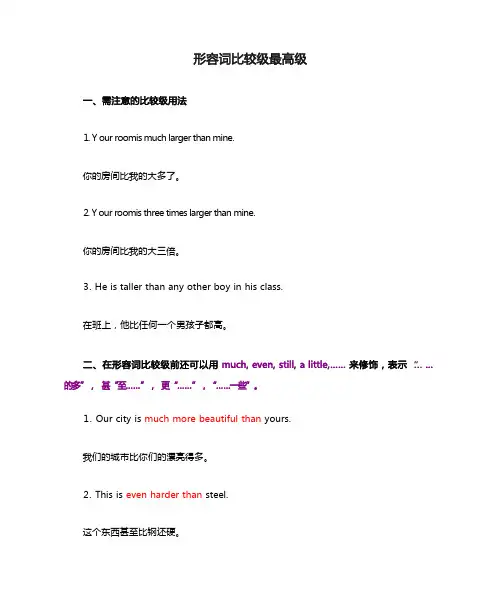
1. Y our roomis much larger than mine.你的房间比我的大多了。
2. Y our roomis three times larger than mine.你的房间比我的大三倍。
3. He is taller than any other boy in his class. 在班上,他比任何一个男孩子都高。
1. Our city is much more beautiful than yours. 我们的城市比你们的漂亮得多。
2. This is even harder than steel.这个东西甚至比钢还硬。
3. He is even slower than before.他比以前更慢了。
4. Japan is a little larger than Germany.日本只比德国大一点儿。
1. Our room is twice larger than theirs.我们的房间比他们的大二倍。
2. The Y angtze River is ten times longer than the river in your city. 长江比你们城市的河长十倍。
1. I'm two years older than you.我比你大二岁。
2. She is a head taller than I ( me ) .她比我高一个头。
(这个句型是用比较级形式表达最高级的意思。
)He is better than any other student in the class.他在班里,比任何一个别的学生都好。
(暗指:他是最好的)注意:any other 后要加单数名词,如果译成“任何一个别的”似乎好理解它为什么接单数名词。
This watch is more expensive than any other watch in the shop.在这个店里,这只表比其他任何一个别的表都贵。
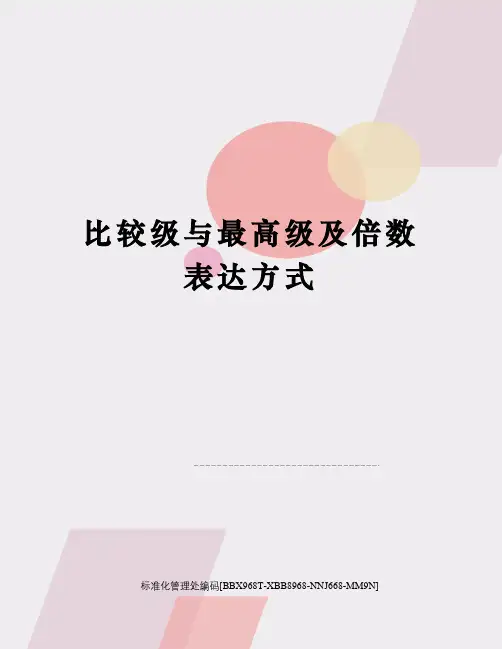
比较级与最高级及倍数表达方式标准化管理处编码[BBX968T-XBB8968-NNJ668-MM9N]比较级与最高级、倍数表达方式一、词的变化规则1)规则变化2) 不规则变化3)more + 形容词/副词原级二、基本结构比较级形容词或副词+thanYou are taller than I.He is the tallest in his class.可修饰比较级的词1)a bit, a little, rather, much, far, by far, many, a lot, lots, a great deal, any, still, even等2)还可以用表示倍数的词或度量名词作修饰语。
3)以上词(除by far)外,必须置于比较级形容词或副词的前面。
典型例题:1)---- Are you feeling ____---- Yes,I'm fine now.A. any wellB. any betterC. quite goodD. quite better2)The experiment was____ easier than we had expected.A.moreB.much moreC.muchD.more much3)If there were no examinations, we should have ___ at school.A. the happiest timeB. a more happier timeC. much happiest timeD.a much happier time the+最高级+比较范围1) The Sahara is the biggest desert in the world.形容词最高级前通常必须用定冠词 the,副词最高级前可不用。
形容词most前面没有the,不表示最高级的含义,只表示"非常"。
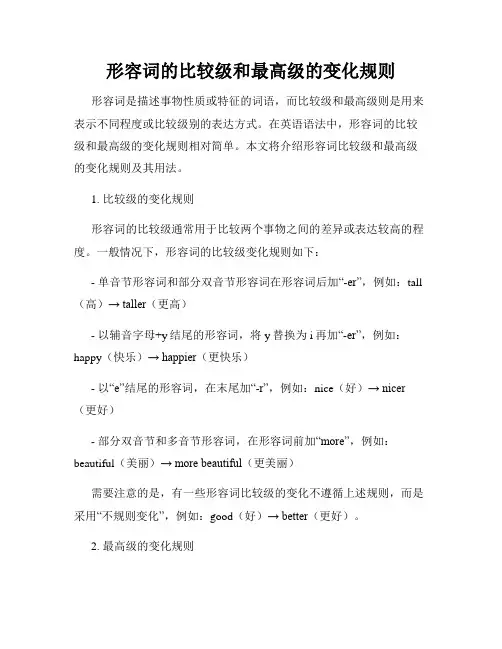
形容词的比较级和最高级的变化规则形容词是描述事物性质或特征的词语,而比较级和最高级则是用来表示不同程度或比较级别的表达方式。
在英语语法中,形容词的比较级和最高级的变化规则相对简单。
本文将介绍形容词比较级和最高级的变化规则及其用法。
1. 比较级的变化规则形容词的比较级通常用于比较两个事物之间的差异或表达较高的程度。
一般情况下,形容词的比较级变化规则如下:- 单音节形容词和部分双音节形容词在形容词后加“-er”,例如:tall (高)→ taller(更高)- 以辅音字母+y结尾的形容词,将y替换为i再加“-er”,例如:happy(快乐)→ happier(更快乐)- 以“e”结尾的形容词,在末尾加“-r”,例如:nice(好)→ nicer (更好)- 部分双音节和多音节形容词,在形容词前加“more”,例如:beautiful(美丽)→ more beautiful(更美丽)需要注意的是,有一些形容词比较级的变化不遵循上述规则,而是采用“不规则变化”,例如:good(好)→ better(更好)。
2. 最高级的变化规则最高级用于表示事物在同一类中的最高程度或最高级别。
最高级的变化规则与比较级不同,一般情况下如下:- 单音节形容词和部分双音节形容词在形容词后加“-est”,例如:tall (高)→ tallest(最高)- 以辅音字母+y结尾的形容词,将y替换为i再加“-est”,例如:happy(快乐)→ happiest(最快乐)- 以“e”结尾的形容词,在末尾加“-st”,例如:nice(好)→ nicest (最好)- 部分双音节和多音节形容词,在形容词前加“most”,例如:beautiful(美丽)→ most beautiful(最美丽)同样需要注意的是,一些形容词的最高级变化也会采用“不规则变化”,例如:good(好)→ best(最好)。
3. 比较级和最高级的用法比较级用于比较两种或两类事物之间的差异,常用结构为“比较级 + than”,例如:- Tom is taller than his brother.- This book is more interesting than that one.最高级用于表示某一事物在同一类中的最高程度,常用结构为“the + 最高级”,例如:- He is the tallest student in our class.- This is the most beautiful painting in the gallery.除了直接使用比较级和最高级外,还可以使用“as + 形容词原级+ as”来表示两个事物在某个方面相同,以及“the same + 形容词原级+ as”来表示两个事物在某个方面完全相同。
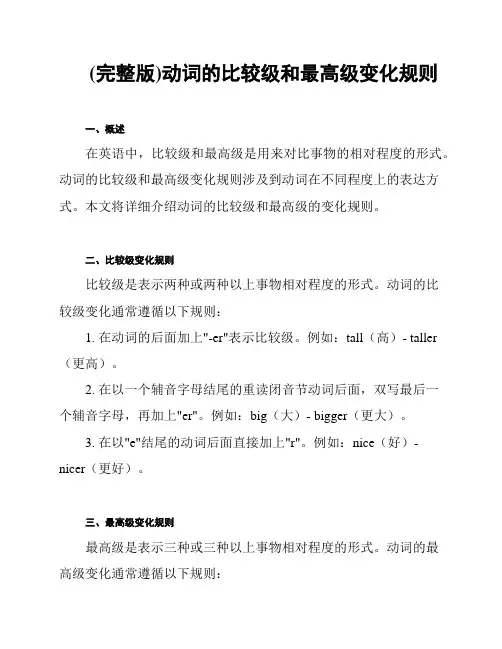
(完整版)动词的比较级和最高级变化规则一、概述在英语中,比较级和最高级是用来对比事物的相对程度的形式。
动词的比较级和最高级变化规则涉及到动词在不同程度上的表达方式。
本文将详细介绍动词的比较级和最高级的变化规则。
二、比较级变化规则比较级是表示两种或两种以上事物相对程度的形式。
动词的比较级变化通常遵循以下规则:1. 在动词的后面加上"-er"表示比较级。
例如:tall(高)- taller (更高)。
2. 在以一个辅音字母结尾的重读闭音节动词后面,双写最后一个辅音字母,再加上"er"。
例如:big(大)- bigger(更大)。
3. 在以"e"结尾的动词后面直接加上"r"。
例如:nice(好)- nicer(更好)。
三、最高级变化规则最高级是表示三种或三种以上事物相对程度的形式。
动词的最高级变化通常遵循以下规则:1. 在动词的后面加上"-est"表示最高级。
例如:tall(高)- tallest(最高)。
2. 在以一个辅音字母结尾的重读闭音节动词后面,双写最后一个辅音字母,再加上"est"。
例如:big(大)- biggest(最大)。
3. 在以"e"结尾的动词后面直接加上"st"。
例如:nice(好)- nicest(最好)。
四、不规则变化除了上述规则,还有一些动词变化的方式比较特殊,需要根据具体情况进行记忆:1. 不规则动词的比较级和最高级通常是通过改变单词本身的形式来实现的。
例如:good(好)- better(更好)- best(最好)。
2. 一些动词在比较级和最高级形式上的变化比较特殊,需要进行特别记忆。
例如:well(好)- better(更好)- best(最好)。
五、总结动词的比较级和最高级变化规则可以帮助我们更准确地描述事物的相对程度。
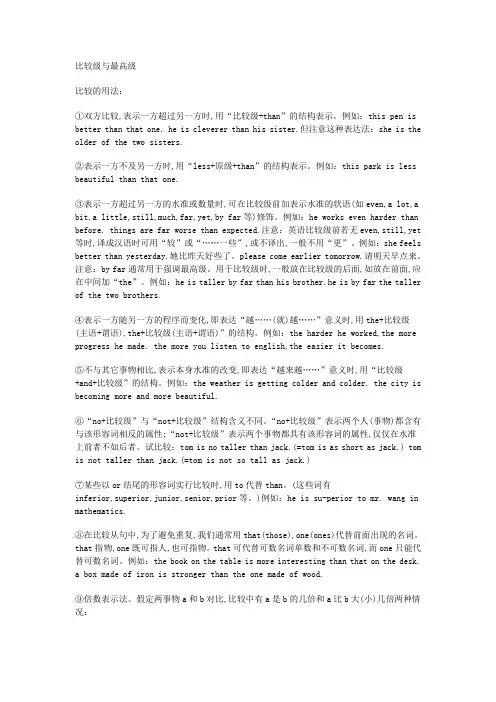
比较级与最高级比较的用法:①双方比较,表示一方超过另一方时,用“比较级+than”的结构表示。
例如:this pen is better than that one. he is cleverer than his sister.但注意这种表达法:she is the older of the two sisters.②表示一方不及另一方时,用“less+原级+than”的结构表示。
例如:this park is less beautiful than that one.③表示一方超过另一方的水准或数量时,可在比较级前加表示水准的状语(如even,a lot,a bit,a little,still,much,far,yet,by far等)修饰。
例如:he works even harder than before. things are far worse than expected.注意:英语比较级前若无even,still,yet 等时,译成汉语时可用“较”或“……一些”,或不译出,一般不用“更”。
例如:she feels better than yesterday.她比昨天好些了。
please come earlier tomorrow.请明天早点来。
注意:by far通常用于强调最高级。
用于比较级时,一般放在比较级的后面,如放在前面,应在中间加“the”。
例如:he is taller by far than his brother.he is by far the taller of the two brothers.④表示一方随另一方的程序而变化,即表达“越……(就)越……”意义时,用the+比较级(主语+谓语),the+比较级(主语+谓语)”的结构。
例如:the harder he worked,the more progress he made. the more you listen to english,the easier it becomes.⑤不与其它事物相比,表示本身水准的改变,即表达“越来越……”意义时,用“比较级+and+比较级”的结构。
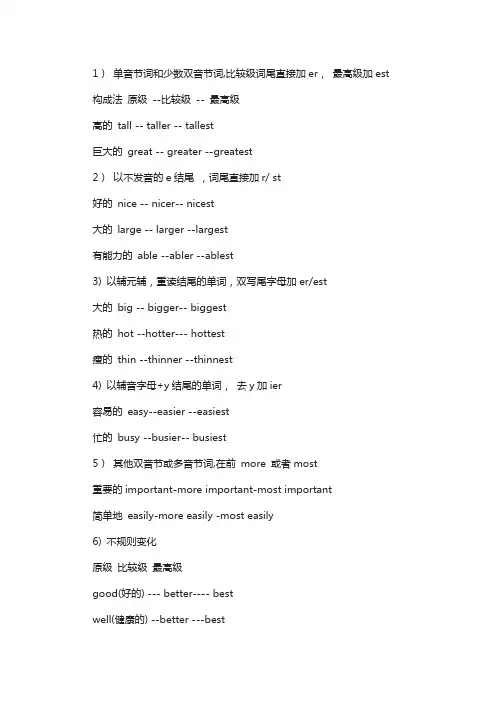
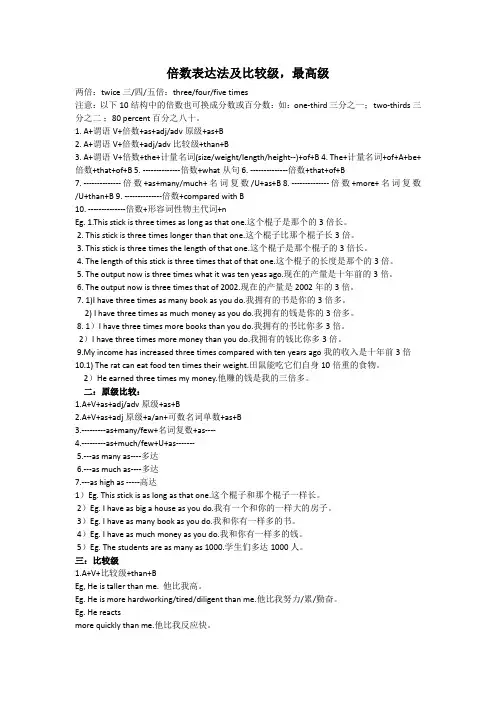
倍数表达法及比较级,最高级两倍:twice 三/四/五倍:three/four/five times注意:以下10结构中的倍数也可换成分数或百分数:如:one-third 三分之一; two-thirds 三分之二;80 percent 百分之八十。
1. A+谓语V+倍数+as+adj/adv原级+as+B2. A+谓语V+倍数+adj/adv比较级+than+B3. A+谓语V+倍数+the+计量名词(size/weight/length/height--)+of+B4. The+计量名词+of+A+be+倍数+that+of+B5. --------------倍数+what从句6. --------------倍数+that+of+B7. --------------倍数+as+many/much+名词复数/U+as+B 8. --------------倍数+more+名词复数/U+than+B 9. --------------倍数+compared with B10. --------------倍数+形容词性物主代词+nEg. 1.This stick is three times as long as that one.这个棍子是那个的3倍长。
2. This stick is three times longer than that one.这个棍子比那个棍子长3倍。
3. This stick is three times the length of that one.这个棍子是那个棍子的3倍长。
4. The length of this stick is three times that of that one.这个棍子的长度是那个的3倍。
5. The output now is three times what it was ten yeas ago.现在的产量是十年前的3倍。
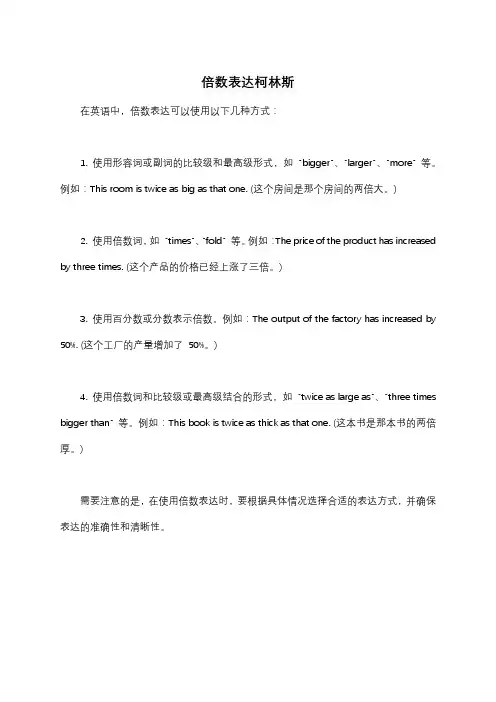
倍数表达柯林斯
在英语中,倍数表达可以使用以下几种方式:
1. 使用形容词或副词的比较级和最高级形式,如 "bigger"、"larger"、"more" 等。
例如:This room is twice as big as that one. (这个房间是那个房间的两倍大。
)
2. 使用倍数词,如 "times"、"fold" 等。
例如:The price of the product has increased by three times. (这个产品的价格已经上涨了三倍。
)
3. 使用百分数或分数表示倍数。
例如:The output of the factory has increased by 50%. (这个工厂的产量增加了 50%。
)
4. 使用倍数词和比较级或最高级结合的形式,如 "twice as large as"、"three times bigger than" 等。
例如:This book is twice as thick as that one. (这本书是那本书的两倍厚。
)
需要注意的是,在使用倍数表达时,要根据具体情况选择合适的表达方式,并确保表达的准确性和清晰性。
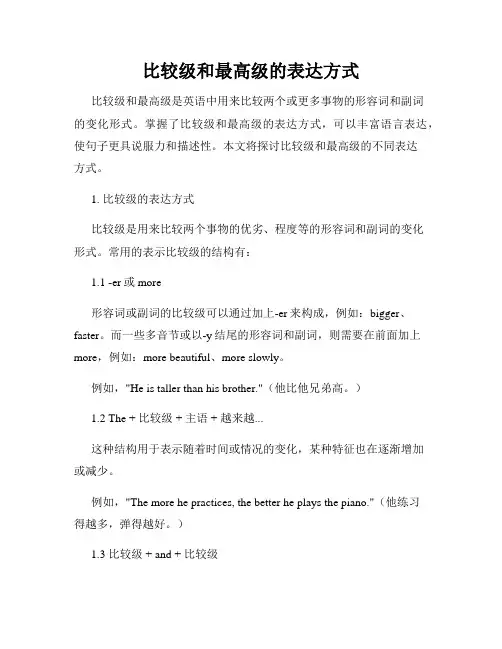
比较级和最高级的表达方式比较级和最高级是英语中用来比较两个或更多事物的形容词和副词的变化形式。
掌握了比较级和最高级的表达方式,可以丰富语言表达,使句子更具说服力和描述性。
本文将探讨比较级和最高级的不同表达方式。
1. 比较级的表达方式比较级是用来比较两个事物的优劣、程度等的形容词和副词的变化形式。
常用的表示比较级的结构有:1.1 -er或more形容词或副词的比较级可以通过加上-er来构成,例如:bigger、faster。
而一些多音节或以-y结尾的形容词和副词,则需要在前面加上more,例如:more beautiful、more slowly。
例如,"He is taller than his brother."(他比他兄弟高。
)1.2 The + 比较级 + 主语 + 越来越...这种结构用于表示随着时间或情况的变化,某种特征也在逐渐增加或减少。
例如,"The more he practices, the better he plays the piano."(他练习得越多,弹得越好。
)1.3 比较级 + and + 比较级用于强调两种或两个以上的特征或情况,比较级的形式可以在and 后再次出现。
例如,"The book is getting more and more popular, and the author is becoming more and more famous."(这本书越来越受欢迎,作者也越来越有名。
)2. 最高级的表达方式最高级是用来将三个或三个以上的事物进行比较,表示最高或最低程度的形容词和副词的变化形式。
常见的最高级的表达方式有:2.1 -est或most形容词或副词的最高级可以通过加上-est来构成,例如:biggest、fastest。
而一些多音节或以-y结尾的形容词和副词,则需要在前面加上most,例如:most beautiful、most slowly。
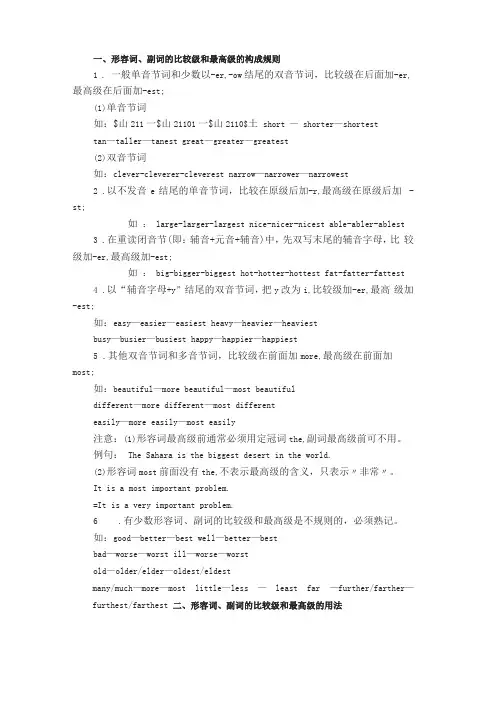
一、形容词、副词的比较级和最高级的构成规则1. 一般单音节词和少数以-er,-ow结尾的双音节词,比较级在后面加-er, 最高级在后面加-est;(1)单音节词如:$山211一$山21101一$山2110$土short — shorter—shortesttan—taller—tanest great—greater—greatest(2)双音节词如:clever-cleverer-cleverest narrow—narrower—narrowest2.以不发音e结尾的单音节词,比较在原级后加-r,最高级在原级后加-st;如: large-larger-largest nice-nicer-nicest able-abler-ablest3.在重读闭音节(即:辅音+元音+辅音)中,先双写末尾的辅音字母,比较级加-er,最高级加-est;如: big-bigger-biggest hot-hotter-hottest fat-fatter-fattest4.以“辅音字母+y”结尾的双音节词,把y改为i,比较级加-er,最高级加-est;如:easy—easier—easiest heavy—heavier—heaviestbusy—busier—busiest happy—happier—happiest5.其他双音节词和多音节词,比较级在前面加more,最高级在前面加most;如:beautiful—more beautiful—most beautifuldifferent—more different—most differenteasily—more easily—most easily注意:(1)形容词最高级前通常必须用定冠词the,副词最高级前可不用。
例句:The Sahara is the biggest desert in the world.(2)形容词most前面没有the,不表示最高级的含义,只表示〃非常〃。

英语比较级和最高级的用法归纳一、比较级(Comparative Degree)1. 表示两者之间的比较:在形容词或副词前加-er,或在形容词前加more。
例如:taller, faster, more beautiful2. 不规则变化:部分形容词和副词的比较级是不规则的,需要记忆。
例如:good - better, bad - worse, far - farther/further, late - later3. 比较级前的修饰语:当比较级前有修饰语时,可以使用much, a lot, a little, a bit等词语来表示程度。
例如:much better, a little faster4. 表示倍数的比较:使用倍数+as+形容词/副词的原级+as。
例如:three times as fast as5. 表示两者以上之间的比较:使用the + 最高级。
例如:the tallest, the fastest二、最高级(Superlative Degree)1. 表示三者或三者以上之间的比较:在形容词或副词前加-est,或在形容词前加most。
例如:tallest, fastest, most beautiful2. 不规则变化:部分形容词和副词的最高级是不规则的,需要记忆。
例如:good - best, bad - worst, far - farthest/furthest, late - latest3. 最高级前的修饰语:当最高级前有修饰语时,可以使用by far, almost, nearly等词语来表示程度。
例如:by far the best, almost the worst4. 表示倍数的最高级:使用倍数+as+形容词/副词的原级+as。
例如:three times as fast as the fastest5. 表示所有事物中的最高程度:使用on earth, in the world等词语。
一倍数表达法是历届高考的热点。
当我们要表达甲是乙的几倍时,通常可使用以下句型:1. 倍数+ as + 形容词或副词的原级+ as + 其他。
这种结构又常演变成下列两类:①倍数+ as + many + 可数名词复数+ as;②倍数+ as +much + 不可数名词+ as。
如:There are seven times as many people as I expected.是我预料的人数的七倍。
There is five times as much coffee in this glass as in that one.这个杯子里的咖啡是那个杯子里的五倍。
2. 倍数+ 形容词(或副词)的比较级+ than + 其他。
如:The hall is five times bigger than our classroom. 这个大厅的面积比我们教室大五倍。
3. 倍数+ the size / height / length / width. etc. + of + 其他。
如:This road is six times the length of that one. 这条路是那条路的六倍长。
4. 计量名词+ of + 名词+ be +倍数+ that + of + 其他。
如:The size of the newly broadened square is four times that of the previous one.新扩建的广场为以前的四倍大。
5. 倍数+what从句。
如:The production is now three times what it was ten years ago.现在的产量是十年前的三倍。
6. 倍数+ more + 名词+ than +其他。
如:There are nine times more books in his bag than in yours.他书包里的书比你书包里的书多九倍。
形容词和副词的比较级和最高级用法和构成法I 形容词和副词的比较级和最高级的用法1)同级比较。
常用句型为:肯定结构:as+形容词(副词)原级+ as否定结构:not so (as)+形容词(副词)原级+as如:Our garden is as beautiful as theirs.Jane didn't write as/so carefully as her elder sister.上述本句型前可以有表示倍数或分数的修饰语,如:This room is three times as large as that one.2)程度不等的比较,常与than连用,其基本句型是:A+形容词(副词)比较级+ than B如:Shanghai is bigger than any other city in China. Which do you like better, strawberries or grapes?3)最高级。
最高级用于三者或三者以上的比较,其结构是:the+形容词(副词)最高级+比较范围(of/among/in短语)如:Spring is the best season in Shanghai. David is the cleverest among the three brothers. Tom jumps (the) farthest of all the students.注:副词的最高级前the可以省略。
II 学习比较等级时的—些注意事项1)比较的对象应当一致。
如:It's hotter in Guangzhou than Beijing.(误)It's hotter in Guangzhou than in Beijing.(正)A woman's heart beats faster than a man.(误)A woman's heart beats faster than a man’s.(正)2)不能与自身相比较。
比较级和最高级的用法英语句子中,将比较两个主体相比较的方法叫做“比较句型”。
典型的是指形容词或副词所表示的质、量或关系的增加:其中,像“A比B更……”的表达方式称为比较级;而“A最……”的表达方式则称为最高级。
基本比较句型一、两者相比(甲=乙,表示甲和乙一样)用“甲as+原级+as乙”句型1、 Tom is as tall as Mike.2、(倍数+as+形容词/副词原级+ as)This rope is three times as long as that one.3、(倍数+ the + n. + of)This rope is three times the length of that one.二、两者相比(甲<乙,表示甲不如乙)用“甲+not as(so) +原级+as+乙”或“less than”表示1、I didn’t do my homework so(as) carefully as you.2、The picture is less attractive than that one.三、两者相比(甲>乙,表示甲比乙强)用“甲+比较级+than+乙”表示1、O ur city is more beautiful than any other city in our country.2、T his rope is three times longer than that one.(倍数+形容词/副词比较级+than)注意:①在含有连词than的比较级中,前后的比较对象必须是同一范畴,即同类事物之间的比较。
a)The population of Shanghai is larger than that of Beijing.b)It is easier to make a plan than to carry it out.c)His shirt is more expensive than mine(my shirt).(如果主语是物主代词+名词,那么后面要用名词性物主代词.)d)He is older than me.(than是介词,后面是人称代词时用宾格)e)Skiing is more exciting than skating. (比较对象可以是名词,短语,从句)②为了避免重复,在从句中常用one, that, those等词来代替前面提过的名词。
英语比较级和最高级的用法归纳英语比较级和最高级的用法归纳英语是一种西日耳曼语支,最早被中世纪的英国使用,并因其广阔的殖民地而成为世界使用面积最广的语言。
以下是店铺整理的英语比较级和最高级的用法归纳,仅供参考,大家一起来看看吧。
一、形容词、副词的比较级和最高级的构成规则1.一般单音节词和少数以-er,-ow结尾的双音节词,比较级在后面加-er,最高级在后面加-est;(1)单音节词如:small→smaller→smallest short→shorter→shortesttall→taller→tallest great→greater→greatest(2)双音节词如:clever→cleverer→cleverest narrow→narrower→narrowest2.以不发音e结尾的单音节词,比较在原级后加-r,最高级在原级后加-st;如:large→larger→largest nice→nicer→nicest able→abler→ablest3.在重读闭音节(即:辅音+元音+辅音)中,先双写末尾的辅音字母,比较级加-er,最高级加-est;如:big→bigger→biggest hot→hotter→hottest fat→fatter→fattest4.以“辅音字母+y”结尾的双音节词,把y改为i,比较级加-er,最高级加-est;如:easy→easier→easiest heavy→heavier→heaviestbusy→busier→busiest happy→happier→happiest5.其他双音节词和多音节词,比较级在前面加more,最高级在前面加most;如:beautiful→more beautiful→most beautifuldifferent→more different→most differenteasily→more easily→most easily注意:(1)形容词最高级前通常必须用定冠词the,副词最高级前可不用。
比较级和最高级的变化形式在英语语法中,比较级和最高级是用来比较两个或多个事物的程度或性质。
了解比较级和最高级的变化形式,能够帮助我们在日常交流和写作中表达更准确和丰富的意思。
本文将介绍比较级和最高级的变化形式,并提供一些例句来帮助读者加深理解。
一、比较级的变化形式在大多数情况下,我们在形容词和副词前加上 "-er" 或 "-ier" 来表达比较级。
如果单音节词以 "e" 结尾,我们只需添加 "r";如果以辅音字母结尾,我们需要在末尾双写辅音字母,并加上 "er"。
以下是比较级的变化形式示例:1. 形容词的比较级变化:- old(老)→ older(更老的)- fast(快)→ faster(更快的)- small(小)→ smaller(更小的)2. 副词的比较级变化:- slowly(慢慢地)→ more slowly(更慢地)- happily(快乐地)→ more happily(更快乐地)- well(好地)→ better(更好地)对于少数不规则的词,比较级的变化形式需特别注意。
例如:- bad(坏)→ worse(更糟糕的)- little(小)→ less(更少的)二、最高级的变化形式最高级用于表达三个或更多事物之间的比较,表示在某一属性或程度上最高的情况。
最高级的变化形式大致与比较级相似,但通常在形容词和副词前加上 "-est" 或 "-iest"。
以下是最高级的变化形式示例:1. 形容词的最高级变化:- old(老)→ oldest(最老的)- fast(快)→ fastest(最快的)- small(小)→ smallest(最小的)2. 副词的最高级变化:- slowly(慢慢地)→ most slowly(最慢地)- happily(快乐地)→ most happily(最快乐地)- well(好地)→ best(最好地)同样地,最高级形式也存在一些不规则变化的词汇:- good(好)→ best(最好的)- bad(坏)→ worst(最糟糕的)三、其他比较级和最高级的表达方式除了加上 "-er" 和 "-est" 的形式外,我们还可以使用 "more" 和"most" 来表示比较级和最高级。
比的知识点总结比的知识点总结比是一种语法现象,在语言中经常被使用。
它用来表示两个事物之间的相似或对比关系。
在比的结构中,通常会使用一个比较对象,即被比较的事物,和一个比较标准,即用来进行比较的参照物。
比在语言中有很多不同的用法和表达方式,如比较级、最高级、均衡比较、倍数比较等。
以下将对比的一些常见知识点进行总结。
1. 比较级(Comparative)比较级是指在两个事物或多个事物之间进行对比时使用的形式。
比较级有两种形式,一种是添加“-er”或“-ier”后缀,如“bigger (更大)”,“happier(更快乐)”;另一种是在前面加上“more”或“less”,比如“more interesting(更有趣的)”,“less complicated(更简单的)”。
比较级主要用于描述两个事物之间的大小、重要性、速度、质量等方面的差异。
2. 最高级(Superlative)最高级是指在多个事物之间进行对比时使用的形式。
最高级的形式通常是在形容词后面加上“-est”或“-iest”的后缀,如“biggest(最大的)”,“happiest(最开心的)”。
与比较级相似,最高级也可以通过在前面加上“most”或“least”来形成。
最高级主要用于描述三个或三个以上事物之间的大小、重要性、速度、质量等方面的差异。
3. 均衡比较(Equative)均衡比较是指在两个相等的事物之间进行对比时使用的形式。
均衡比较的结构通常是“as + 形容词 / 副词+ as”,如“as tall as (和...一样高)”,“as quickly as(和...一样快)”。
均衡比较用于表示两个事物具有相同的程度、大小、速度等。
4. 倍数比较(Multiple Comparison)倍数比较是指通过使用倍数词语来对两个事物进行比较。
倍数词语包括“twice(两倍)”,“three times(三倍)”,“half(一半)”,“double(加倍)”等。
比较级与最高级及倍数
表达方式
集团企业公司编码:(LL3698-KKI1269-TM2483-LUI12689-ITT289-
比较级与最高级、倍数表达方式一、词的变化规则
1)规则变化
2)不规则变化
3)more+形容词/副词原级
二、基本结构
比较级形容词或副词+than
YouaretallerthanI.
Heisthetallestinhisclass.
可修饰比较级的词
1)
abit,alittle,rather,much,far,byfar,many,alot,lots,agreatdeal,an y,still,even等
2)还可以用表示倍数的词或度量名词作修饰语。
3)以上词(除byfar)外,必须置于比较级形容词或副词的前面。
典型例题:
1)----Areyoufeeling____
----Yes,I'mfinenow.
A.anywell
B.anybetter
C.quitegood
D.quitebetter
2)Theexperimentwas____easierthanwehadexpected.
A.more
B.muchmore
C.much
D.moremuch
3)Iftherewerenoexaminations,weshouldhave___atschool.
A.thehappiesttime
B.amorehappiertime
C.muchhappiesttime
D.amuc hhappiertime
the+最高级+比较范围
1)TheSaharaisthebiggestdesertintheworld.
形容词最高级前通常必须用定冠词the,副词最高级前可不用。
形容词most前面没有the,不表示最高级的含义,只表示"非常"。
Itisamostimportantproblem.
=Itisaveryimportantproblem.
注意:使用最高级要注意将主语包括在比较范围内。
(错)Tomisthetallestofhisthreebrothers.
(对)Tomisthetallestofthethreebrothers.
2)下列词可修饰最高级,byfar,far,much,mostly,almost Thishatisnearly/almostthebiggest.
注意:
a.very可修饰最高级,但位置与much不同。
Thisistheverybest.
Thisismuchthebest.
b.序数词通常只修饰最高级。
Africaisthesecondlargestcontinent.
3)句型转换:
Mikeisthemostintelligentinhisclass. Mikeismoreintelligentthananyotherstudentsinhisclass. 4)"否定词语+比较级","否定词语+so…as"结构表示最高级含义。
Nothingissoeasyasthis.
=Nothingiseasierthanthis.
=Thisistheeasiestthing.
倍数的表达方式
1.“…?times?+形容词?/?副词的比较级+?than?…”例如:
This?hall?is?five?times?bigger?than?our?classroom.
2.“…?times?+as?+?形容词?/?副词的原级+?as?…”例如:
This?table?is?three?times?as?long?as?that?one.?
3.“…?times?+?the?+?名词
(如:?size,?height,?weight,?length,?width,?age等)+?of?…”例如:
This?street?is?four?times?the?length?of?that?street.
4.“…?times?+?more?+名词+?than?…”例如:
There?are?twice?more?students?in?our?class?than?in?theirs .?
5.“…?times?+?what?从句”例如:
The?price?of?the?meat?is?twice?what?it?was?last?year.? 6.“…?times?+?up?on?(或?over?)…
He?is?three?times?up?on?your?age.
7.“…?+by?+?…?times?”例如:
His?speed?is?faster?than?mine?by?four?times.
8.“…?times?+?compared?with?+被比较对象”例如:
The?number?of?the?students?in?our?school?has?increased?four ?times?compared?with?1980.
9.“…?times?+?that?of?+?被比较对象”例如:
In?this?workshop?the?output?of?July?was?three?times?th at?of?January.
和more有关的词组
1)themore…themore…越……就越……
Theharderyouwork,thegreaterprogressyou'llmake.
2)moreBthanA与其说A不如说B
=lessAthanB
Heismorelazythanslowathiswork.
=Heislessslowthanlazyathiswork.
3)nomore…than…与……一样不……,(对两者同时否定)
nomorethan仅仅
notmorethan不多于,至多
not….morethan…
Eg:Heisnomoreawriterthanapainter.
Hehasnomorethanthreechildren.
Hehasnotmorethanthreechildren.
Sheisnotmorecleverthanheis.
noless…than…不亚于
nolessthan多达
notlessthan意为“不下于”、“至少”notless…than与……一样……
Eg:Heisnolessdiligentthanyou.
Wewalkednolessthanthreemiles.
Hehasnotlessthansevendaughters.
SheisnotlessbeautifulthanMary.。